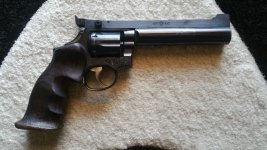Idaho shooter
Inactive
Hi everyone,
This is my first post since registering. I have been reading this forum for
many years and gotten a lot of useful info from many knowledgeable people.
I have several S&W revolvers including models 10,19,63, and 686, All are good
shooters with 686 being the most accurate center fire handgun I have ever
shot. I have a question about my model 10. I purchased it used about 10
years ago in unfired condition and is still nearly so. According to it's serial no.
S&W tells me is was made in 1972. It does not have a model no. stamped in
the crane. Has anyone seen one with this missing?
This is my first post since registering. I have been reading this forum for
many years and gotten a lot of useful info from many knowledgeable people.
I have several S&W revolvers including models 10,19,63, and 686, All are good
shooters with 686 being the most accurate center fire handgun I have ever
shot. I have a question about my model 10. I purchased it used about 10
years ago in unfired condition and is still nearly so. According to it's serial no.
S&W tells me is was made in 1972. It does not have a model no. stamped in
the crane. Has anyone seen one with this missing?

